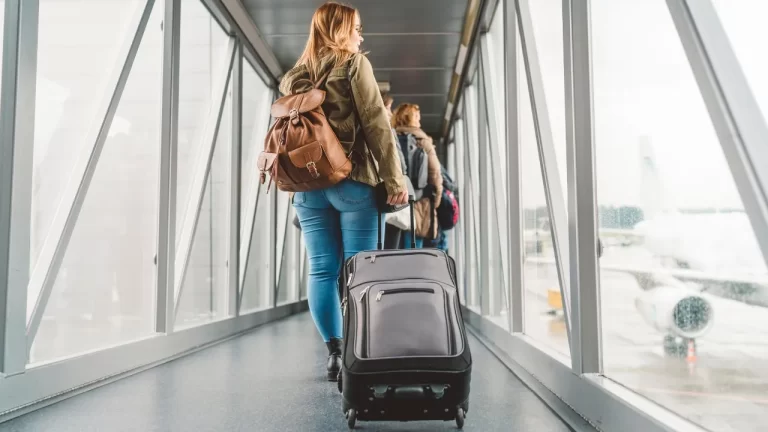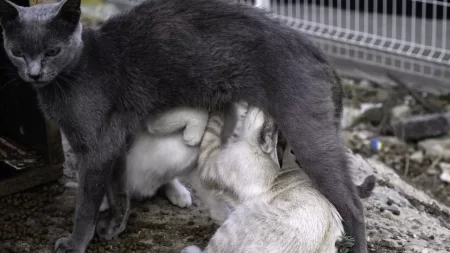Wet and dry cat food are allowed on flights, according to the Transportation Security Administration (TSA) website. However, some limits apply.
Dry or “moist” pet food is solid food that may be taken in carry-on or checked luggage under airline weight limitations.
Wet pet food is a liquid for carry-on luggage and must follow the 3-1-1 rule. Wet pet food must fit in a quart-sized, transparent zip-lock bag per passenger and be less than 3.4 oz (100 milliliters). Even service animals and prescription pet food are not exempt.
Pet food may be removed from carry-on luggage during security screening to ensure a clean picture.
Avoid feeding cats in the cottage. Feeding cats on planes may induce nausea, upset stomach, diarrhea, and stress.
TSA Regulations for Bringing Cat Food on a Plane
The Transportation Security Administration (TSA) controls the airport security checkpoint and decides what can and can’t be brought on to planes. An x-ray machine screens carry-on and checked luggage. They have two rules that apply to flying with cat food, one rule for dry cat food and one rule for wet cat food.
Understanding the Difference Between Wet and Dry Food
Wet cat food is considered a liquid or gel-like substance, while dry or “moist” cat food is considered a solid food. This distinction is important because liquids and gels have stricter restrictions than solids when it comes to carry-on bags.
Quantity Restrictions and Packing Guidelines
For carry-on travel with wet cat food, permissible containers must hold 3.4 ounces (100 ml) or less. They should reside in a transparent, quart-sized zip-top bag, shared with any other liquid or gel substances. Only one such bag is permitted per traveler, which needs to be presented separately from the carry-on for checkpoint screening.
As for dry cat food, no quantity restrictions apply for carry-on transport. However, you must observe any weight or size limits enforced by your airline. To maintain clarity during x-ray imaging, dry cat food should be stowed separately from items such as electronics, books, or clothing. Storing it in zip-top bags or plastic containers is recommended.
Regarding both wet and dry cat food, there is no quantity limit for checked luggage. Yet, airline-specific weight and size restrictions for checked bags may apply. Ensure your cat food is packed securely to avoid any spillage or damage.
Carrying Cat Food in Carry-On or Checked Luggage
Deciding where to stow your cat food for travel – in your hand luggage or in your checked bag – is contingent on multiple factors like flight duration, cat food availability at your landing point, and your feline’s preference.
There are benefits to having cat food in your carry-on bag:
- You can access it during the flight if your cat gets hungry or thirsty
- You can avoid potential loss or damage of your cat food if your checked luggage gets delayed or mishandled
- You can avoid potential fees for extra weight or extra bags for your checked luggage
Some advantages of carrying cat food in your checked luggage are:
- You can bring more quantity and variety of cat food without worrying about the 3-1-1 liquids rule
- You can avoid potential hassle or confusion at the security checkpoint
- You can free up space and weight in your carry-on bag for other items
Ultimately, the choice is up to you and what works best for you and your cat.
Tips for Traveling with Cat Food on a Plane
Traveling with a cat by plane can be stressful for both you and your furry friend, but there are some things you can do to make it easier and safer. Here are some tips for traveling with cat food on a plane:
Choosing the Right Packaging for Air Travel
When packing your cat food for air travel, you should choose packaging that is:
- Leak-proof: To prevent spills or messes in your luggage or on the plane
- Resealable: To keep the cat food fresh and prevent odors
- Durable: To withstand pressure changes and rough handling
- Easy to open: To avoid using scissors or knives that might not be allowed on board
- Labeled: To identify the contents and avoid confusion
Some examples of suitable packaging are:
- Original containers: If they meet the criteria above
- Zip-top bags: For small portions of dry or wet cat food
- Plastic containers: For larger portions of dry or wet cat food
- Pouches: For single servings of wet cat food
Ensuring You Have Enough Food for the Duration of the Trip
Before traveling with your cat by plane, you should calculate how much food your cat will need for the duration of the trip, including the flight time, the transit time, and the time at your destination. You should also factor in any delays or emergencies that might occur. You should bring enough food to cover your cat’s needs, plus some extra in case of unforeseen circumstances. You should also check the expiration date of your cat food and make sure it will last until the end of your trip.
Labeling and Organizing Your Cat Food for Easy Inspection
To avoid any problems or delays at the security checkpoint, you should label and organize your cat food clearly and neatly. You should:
- Write the name and quantity of the cat food on the packaging
- Place wet cat food in a clear, quart-sized zip-top bag
- Separate dry cat food from other items in your carry-on bag
- Place any medications or supplements for your cat in a separate zip-top bag
- Have your cat’s health records and certificates handy
Checking with Your Airline for Additional Restrictions
Different airlines may have different policies and procedures for traveling with a cat and cat food. You should check with your airline before booking your flight and before traveling to find out:
- If they allow cats to travel in the cabin or only in the cargo hold
- If they have any breed or size restrictions for cats
- If they have any specific requirements for pet carriers or harnesses
- If they charge any fees for traveling with a cat
- If they have any special instructions or tips for traveling with a cat
International Travel: Customs and Regulations for Bringing Cat Food
If you are flying internationally with your cat, you need to be aware of the customs and regulations for bringing cat food into your destination country. Different countries may have different rules and restrictions for importing animal products, such as cat food, to prevent the spread of diseases or pests. You should:
Check Restrictions in Your Destination Country
Before traveling to a foreign country with your cat, you should research the restrictions and requirements for bringing cat food into that country. You can use online resources, such as the USDA APHIS Pet Travel website, to find information about specific countries and regions. You can also contact the embassy or consulate of your destination country to get the most updated and accurate information.
Some of the things you should check are:
- If you need a permit or certificate to bring cat food into the country
- If there are any limits on the quantity or type of cat food you can bring
- If there are any bans or prohibitions on certain ingredients or sources of cat food
- If there are any special packaging or labeling requirements for cat food
- If there are any fees or taxes for bringing cat food into the country
Declare Any Cat Food You Are Bringing
When arriving at your destination country, you will need to go through customs and declare any items you are bringing into the country, including cat food. You should:
- Fill out any forms or declarations required by the customs authorities
- Have your receipts or invoices for your cat food ready
- Have your permit or certificate for your cat food ready, if applicable
- Be honest and accurate about the quantity and type of cat food you are bringing
- Be prepared to answer any questions or explain any details about your cat food
Understand Health Certificate Requirements
In addition to declaring your cat food, you will also need to provide a health certificate for your cat to prove that they are healthy and vaccinated. The health certificate must be issued by a licensed veterinarian within a certain time frame before your departure date. The health certificate must also be endorsed by a government official from your origin country, such as a USDA APHIS veterinarian. The health certificate must include:
- Your name and contact information
- Your cat’s name, breed, age, sex, color, and markings
- Your cat’s microchip number, if applicable
- Your cat’s vaccination history, including rabies and other, required vaccines
- Your cat’s health status and history, including any tests or treatments done
- Your destination country and address
You should make copies of your health certificate and keep them with you at all times during your trip. You should also check with your destination country if they have any additional requirements or specifications for the health certificate.
Conclusion
Traveling by plane with a cat poses challenges, yet it can be fulfilling when relocating overseas or embarking on an extended adventure with your feline companion. Adhering to TSA regulations regarding cat food transportation on flights, alongside the advice provided in this article, ensures a secure and seamless journey for both you and your cat.







